Please note, this page is full of photos and text, so if you do not have Broadband, please allow a good few minutes for it to load in full!
The Life History of Syd Barrett
1946-2006
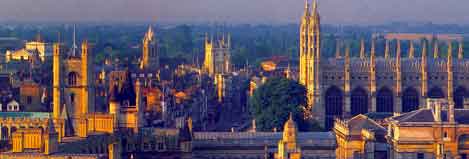
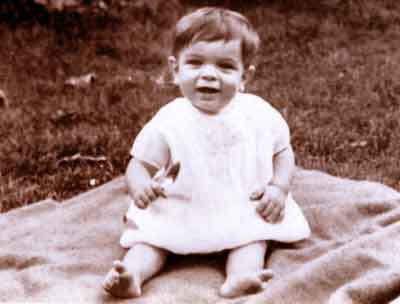
SYD (NEE ROGER) AGED 18 MONTHS
Roger Keith Barrett was born in Cambridge, England, on January 6, 1946. The fourth of five children raised by Dr. Arthur Max Barrett and his wife Winifred. Growing up in the genteel University town, the young Roger enjoyed a colourful middle-class English childhood, complete with a stint in the Boy Scouts.

SYD AT A BOY SCOUTS CAMP, AGED 13
As well as camping and sports, he soon developed interests in more creative fields such as drama, painting and above all music. His Dad, a respected Pathologist, enjoyed classical music, and tuneful get-togethers around the family piano were an integral part of his five children's upbringing. However this idyllic scene, was destroyed by Dr. Barrett's death in 1960. On that bleak day of December 11, Roger's diary entry had been left blank. To those close to him, he'd simply expressed "poor Dad died today".
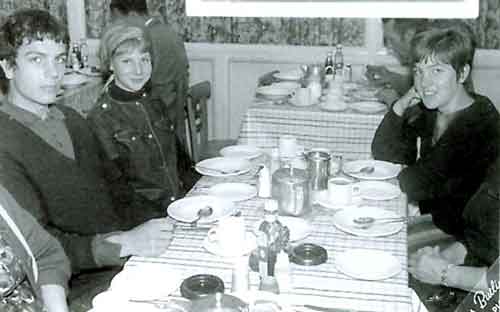
SYD PICTURED WITH THEN GIRLFRIEND LIBBY GAUSDEN AND HIS SISTER ROSEMARY
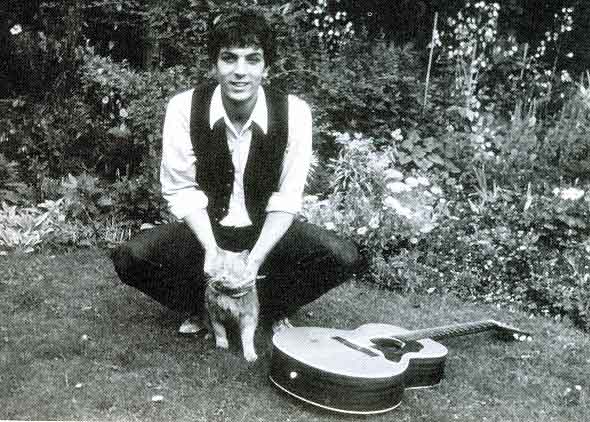
SYD AGED 16 WITH THE FAMILY CAT 'FRISKY" IN THE BACKYARD AT HILLS ROAD, CAMBRIDGE
By this time Roger had aquired his first guitar and the nickname Syd. The nickname originated from him attending the Cambridge, Riverside Jazz Club. One of the regulars there, was a drummer named Sid Barrett. A comparison was made and once Roger's schoolmates picked up on this, the nickname stuck. Roger however, would go on to spell his new name with a Y instead of an I.
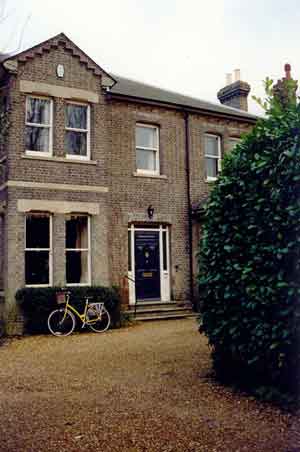
THE HILLS ROAD FAMILY HOME
Syd had many friends who would visit the Barrett family home, and one of his closest friends was another aspiring guitarist named David Gilmour, with whom Syd regularly traded guitar riffs and ideas. Although Gilmour boasted a far superior technique, Barrett was more musically inventive, and in turn they both learnt a great deal from each other.
After playing an acoustic duo at a Cambridge club called The Mill, Syd and Dave spent a summer together bumming around France, playing for small change. Another long-time friend and associate was Storm Thorgerson (of Hipgnosis fame) who remembers Syd as “a bright extroverted kid, very outgoing, and having no problems pulling chicks”. Having demonstrated tremendous prowess as a painter, Barrett won a scholarship at London's Camberwell School of Art.
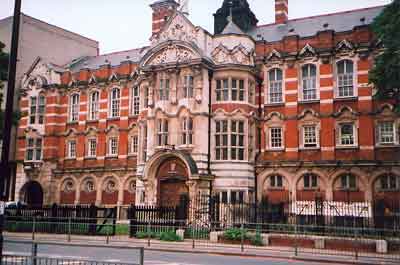
THE ART GALLERY, LONDON'S CAMBERWELL COLLEGE OF ARTS
In 1965, to the sorrow of his protective mother, Syd left Cambridge for a flat in London. Roger Waters, a familiar face from Cambridge High and The Mill, promptly invited Barrett to join his embryonic R and B band. Before Syd's arrival, the band had endured several line-up and name changes including Sigma 6, The Architectural Abdabs, Screaming Abdabs or sometimes just the Abdabs. The group's drummer was Nicholas Berkley Mason, a fellow Architecture student from Regent Street Polytechnic, and their keyboardist was Richard William Wright, also a former classmate who had transferred to the London College of Music. When Barrett plugged in, the band already contained a very competent jazz-oriented guitarist, named Bob Close.
Although all the band members viewed their pop group as more of a musical hobby, Syd's painting career was rapidly eclipsed by visions of pop stardom. He started making music in colours, instead of paint and canvas. Barrett's induction to the band, seems to have triggered the exit of Close, who failed to share Syd's enthusiasm for feedback, distortion, eastern mysticism, supernaturalism and ESP. By default Syd found himself fronting the group, coming up with a few short-livednames, like The Spectrum Five, but he promptly settled on and renamed them The Pink Floyd Sound, taking the Christian names of two separate Georgia blues artists, Pink Anderson and Floyd Council. The word "Sound" was soon dropped from the name.
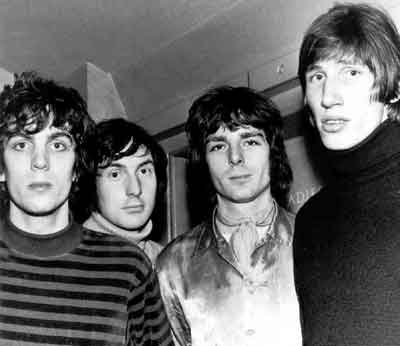
THE FRESH YOUNG LINE-UP
With America's west coast breeding a revolutionary new youth and rock culture, steering into a distinctly psychedelic genre, Syd Barrett grabbed the wheel of the Technicolour tour-bus, installed a super-charger and drove it at light speed through Britain's Underground.

SYD, THE MAIN MAN, AND HIS FELLOW FLOYDIAN TRAVELLERS
This sub-culture first surfaced in a series of Sunday afternoon happenings at London's Marquee Club. Though entertainment generally encompassed a rock band or two, these were hardly the sole focus of attention. Movies flickered on the walls throughout the performances, and little distinction was made between player and audience. Customers were encouraged to dress as outlandishly as possible and to contribute to the general racket with such "found" instruments as transistor radios and lavatory plungers, or by usurping the stage to bellow their own poetry. The Pink Floyd were quickly accepted as a fixture of Spontaneous Underground, and encouraged to stretch out each number for as long as half an hour so as not to interrupt the slow, sinuous swaying of would-be dancers. After about a dozen such Sundays, the Floyd were "discovered" in their natural habitat by a would-be Brian Epstein, named Peter Jenner. Jenner approached them and said, 'You lads could be bigger than the Beatles' and they sort of looked at him and replied in a dubious tone, `Yes, well, we'll see you when we get back from our holidays,' because they were all shooting off for some sun and fun in Europe.
For Jenner there on the stage was this strange band playing a mixture of R&B and electronic noises. He was really intrigued because in between the routine stuff like `Louie Louie' and `Road Runner' they were playing these very weird breaks, so weird that he couldn't even work out which instrument the sound was coming from. It was all very bizarre and just what he was looking for: a far-out, electronic, freaky pop group.
Jenner was startled to learn that the Floyd had no management or agency, minimal equipment (most of it home-made), and so few gigs lined up that they were on the verge of calling it quits altogether. Accordingly, Jenner roped his friend Andrew King into co-managing the Floyd in a six-way partnership called Blackhill Enterprises.
Jenner also encouraged his new clients to emphasize their unique instrumentals at the expense of the R&B chestnuts, while Barrett took it upon himself to furnish the Floyd with songs of their own. "The fact that Syd was a songwriter changed the whole thing," Mason told NME years later. "We could have spent years playing old Stones and Bo Diddley tunes, and wouldn't have achieved anything." Jenner demanded that Barrett's material be as weird as the band's instrumental breaks, yet melodic and lyrical enough for the hit parade, and Syd rose to the occasion with a string of infectious pieces of eccentric English whimsy, influenced in equal measure by Lewis Carroll, C. S. Lewis, and Psychedelic culture (e.g., "Sitting on a unicorn… swimming through the starlit sky…hey-ho! here we go, ever so high!").

A YOUNG CHARASMATIC, AND GIFTED BARRETT
During the summer of 1966, the Pink Floyd acquired another regular gig when the Free School-Alternative London's first community organization-began sponsoring "light and sound workshops" at Notting Hill's All Saints Church, under the aegis of Jenner's close friend John Hopkins. Five years hence, Rick Wright was to reminisce (in NME): "Those early days were purely experimental for us and a time of learning and finding out exactly what we were trying to do. Each night was a complete buzz because we did totally new things and none of us knew how the others would react to it."
At one of the All Saints shows, some American pals of Timothy Leary's elected to project slides onto the group in time with their music. This was a revelation to the Floyd and their managers, who immediately set about constructing the United Kingdom's first light show. In the absence of any blueprints from San Francisco's Fillmore Theatre, Jenner and King improvised a home-made device from sundry slabs of lumber, bits of coloured perspex, and hardware-store spotlights operated by domestic light switches!
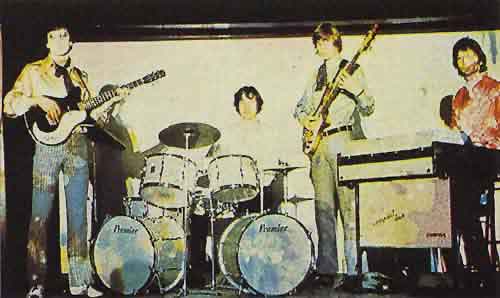
"WITH ELECTRIC LIGHTS FLASHING VERY FAST"
Alternative London found its permanent vortex at the enterprising John Hopkins's new Tottenham Court Road club, UFO, whose tiny stage would serve as a launching pad for the likes of the Soft Machine, Arthur Brown, Procol Harum, Tomorrow, and Tyrannosaurus Rex. But it was Syd Barrett’s Pink Floyd who presided over the December 23 opening-night festivities, and who would remain the official house band of both UFO and the London Underground in general. The band's UFO performances, Mason would tell Zigzag, were often supplemented by "some mad actors, a couple of light shows, perhaps the recitation of some poetry or verse, and a lot of wandering about and cheerful chatter." UFO which Syd Barrett dubbed "a microcosm of what was to happen later", served as the prototype for two other London Underground meccas, christened (in Professor Tolkien's honour) Gandalf's Garden and Middle Earth.
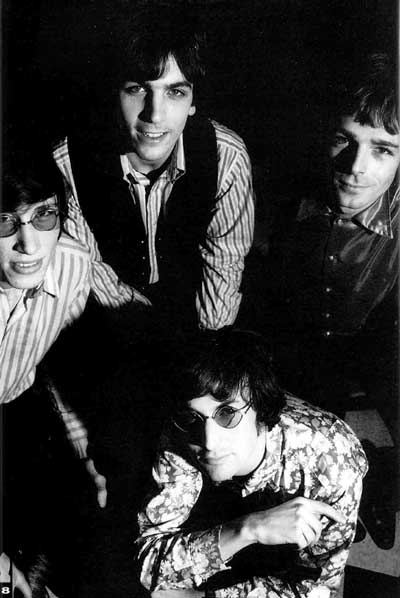
THE DARLING BUDS OF LONDON
It was only a matter of time before conservatively dressed record executives materialised amidst the clouds of sweet-smelling smoke to gingerly pick their way through the sprawling freaks. The Floyd duly signed with the highest bidder, EMI's Beecher Stevens, who later told writer Rick Sanders that he "classified them as weird but good," yet felt that "one of the boys, and some of the people around them, seemed a bit strange” which is one of the reasons he wanted Norman Smith (nicknamed Hurricane), an EMI staff producer and the Beatles' engineer to keep a firm hand on the sessions."
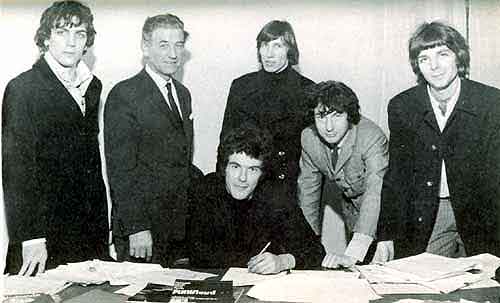
"COME IN HERE DEAR BOY, HAVE A CIGAR, YOU'RE GONNA GO FAR..." THE DEAL IS SIGNED!
The Floyd's first single, however, was produced independently, prior to Smith's instalment, by Jenner's friend and UFO's musical director Joe Boyd. The result was the most auspicious recorded debut by any of the artists, a hook-laden piece of whimsy about the twilight adventures of a transvestite sex pervert called Arnold Layne. According to Waters (in Zigzag), "Arnold Layne" and his "strange hobby" weren't just figments of Barrett's bizarre imagination: Both Roger and Syd's mother’s had students as lodgers, because there was a girl's college up the road. So there were constantly great lines of bras and knickers on their washing lines, and Arnold, or whoever he was, had stolen bits and pieces from them.
Melody Maker was suitably impressed, saying: "First outing from the colourful Pink Floyd with an amusing and colourful story about a guy who got himself put inside because he screwed up whilst learning of the birds and the bees…without doubt, a very good disc. The Pink Floyd represent a new form of music to the English pop scene so let's hope the English are broadminded enough to accept it with open arms."
Oddly enough, "Arnold Layne" triggered a fit of prudery among the ultra-hip pirates of Radio London, who banned the ditty even as the staid old BBC accorded it precious airplay. "Arnold Layne just happens to dig dressing in women's clothing," Syd retorted. "A lot of people do, so let's face up to reality!" His B-side, meanwhile, had run afoul of EMI; as Waters remembered in Zigzag: "We had to change all the lyrics because it was about rolling joints. It was called `Let's Roll Another One' and we had to change the title to `Candy and a Currant Bun.'"
"Arnold" made the Top Twenty. A follow-up, "See Emily Play" (originally called "Games for May" in commemoration of the famous Queen Elizabeth Hall concert), materialized, supposedly "Kubla Khan"-style, after Barrett dozed off in a forest. "Emily" got to number six. The Pink Floyd had arrived in a big way, just in time for the Summer of Love.

SYD SHOWING A CLEAR INTEREST IN FASHION AND LOOKING DIFFERENT
"We are simply a pop group," Waters insisted (in NME). "But because we use light and colour in our act, a lot of people seem to imagine we are trying to put across some message with nasty, evil overtones." The pop weeklies, for their part, greeted the Floyd as harbingers of the New Age. Melody Maker called them "Britain's top psychedelic group a cacophony of sound played to a background of multi-coloured lights." According to NME, the boys themselves came off as "remote, mystical creatures, simply because few people could see them properly”.
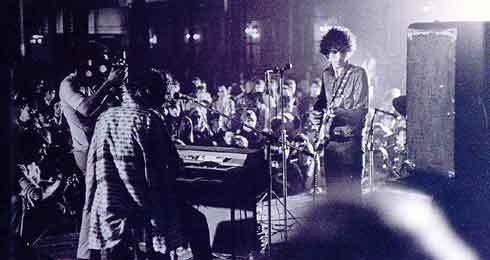
"REACHING THE DIZZY HEIGHTS OF THAT DREAMED OF WORLD"
However…"Suddenly they were stars," Jenner recalled in a radio interview with deejay Mike Sparrow, “which became a very difficult thing for everyone to cope with. Most of all Syd, because from then on everyone was saying: `Is that the next single?' " The current single's success, meanwhile, "instantly put the Floyd on the `Hit Band' circuit, which was mad! People expected them to do a thirty-minute set, a string of hits, and most of all `See Emily Play.'"
The Floyd, however, perversely declined to perform the famous ditty. They could go on doing the same numbers, which is very pop-starish but that's not what the Pink Floyd were all about. It was all about taking risks and pushing forward.

SYD'S FAMOUS, MIRRORRED TELECASTER REFLECTING THE LIQUID LIGHT SHOW
No other album sounds like Piper At the Gates of Dawn, and probably never will. Syd Barrett’s guitar work maintained a psychedelic, dramatic ambience of incongruous contrasts, violent changes and inspired psychosis. Syd’s instrumental mannerisms dominated each song, and Rick Wright’s talent on keyboards helped drive the distinct sound of the colourful train along it’s revolutionary tracks.
From Jenner's perspective, "the first indication that things were going to be a bit difficult" came when the Floyd were booked onto television's Top of the Pops for the three consecutive weeks of "Emily" 's sojourn in the Top Ten. The boys made their first appearance impeccably turned out in the King's Road's best satin and velvet attire. During the second performance, however, Barrett's opulent finery looked as if he had slept in it throughout the intervening week. And for the third Top Of The Pops taping, Syd arrived as the picture of flamboyant elegance, only to disappear into the dressing room and don a set of casual old rags for the cameras.

IN VELVET, PAISLEY AND SATIN FINERY
Shortly after this, said Jenner, "we had to do a radio show (Saturday Club) to promote the single and Syd just walked out and said ‘I never want to do that again.' We had to pull the band off the road, and everybody have a holiday. . . Up to that point Barrett was just a delight, one of the nicest people. It was from that point on that people started saying he was a bit weird."
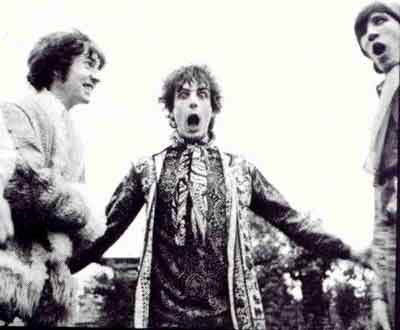
"REFLECTING ELECTRICITY EYES"
PINK FLOOD FLAKE OUT! blurted the front-page headline in Melody Maker. "Lead vocalist and songwriter Syd Barrett is suffering from `nervous exhaustion' and the group have withdrawn from all engagements booked for the month of August.
"He was 100 percent creative, and very hard on himself," co-manager Andrew King would tell Sounds. "He wouldn't do anything unless he thought he was doing it in an artistic way." Barrett applied his unique flair even to the usually humdrum process of mixing the album. He would throw the levers on the board up and down apparently at random, making pretty pictures with his hands. The result can be heard in pieces like "Interstellar Overdrive," where instruments careen from speaker to speaker with dizzying abandon. Interstellar Overdrive's explosive chord progression still reminds me of what a truly dynamic character Syd was!
Originally called Astronomy Domine, the debut LP was retitled The Piper at the Gates of Dawn, after a chapter of Kenneth Graham's The Wind in the Willows. Its release (on August 1, 1967 in the UK) elicited many comparisons with Sgt. Pepper; and these, for once, were justified. Piper was made at the same time as Pepper, at EMI's Abbey Road Studios, and I think that was not a coincidence! The Floyd lads used to go down and hear what was wafting out of the doors, and apparently the Beatles eaves-dropped on the Piper studio, while Barrett and his boys were creating history also.
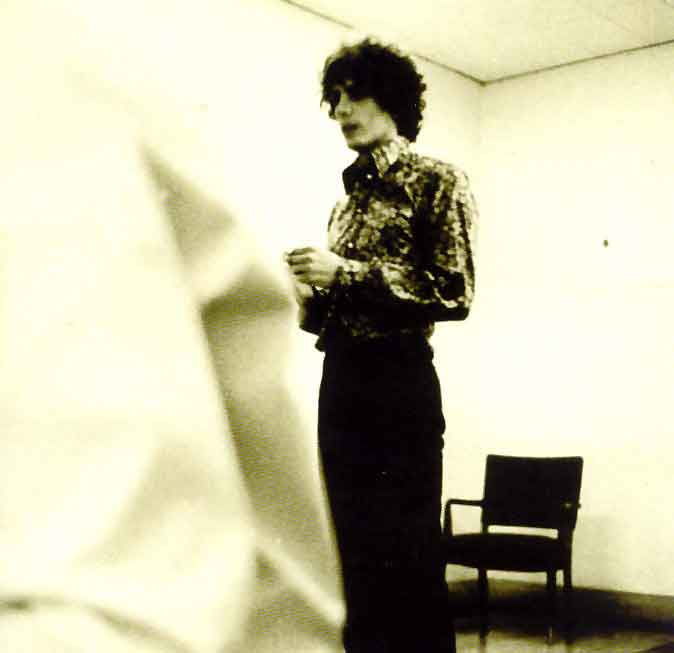
SYD INSIDE ABBEY ROAD STUDIOS
Like Lennon and McCartney, Barrett set stream-of-consciousness fantasy to catchy melodies and commercial pop hooks, often tempering childlike wonder with grown-up irony. He had his Eastern influences, too; "Chapter 24," for instance, fuses devotional chanting with messages from the I Ching. As a guitarist, Syd was similarly innovative and expressive not to mention unpredictable. Without warning, his melodic breaks give way to harsh dissonances, and straightforward strumming to an almost jazz-like improvisation, with little regard for such trifles as key and time signatures.

SYD'S TOOL OF THE TRADE, HIS BINSON ECHOREC BOX
Barrett worked wonders with echo boxes and the wah-wah pedal, and, perhaps most impressively, turned the slide guitar (previously associated mostly with the blues) into an integral component of his space odysseys. Syd’s Piper at the Gates of Dawn was Psychedelic Pop, and everything but conventional, including it’s song titles, like Pow R. Toch H. and Take Up Thy Stethoscope and Walk.
Released later than the UK on September 11, Piper was criminally butchered in the U.S. by Capitol, and released omitting the amazing tracks "Flaming," "Bike," and "Astronomy Domine.
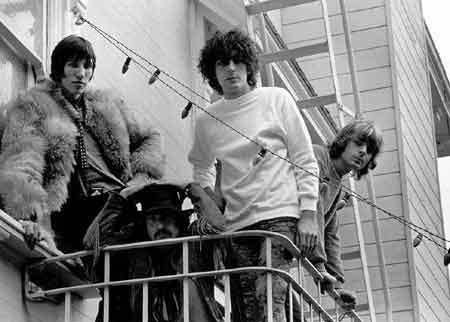
ON THE BALCONY OF THEIR HOTEL IN SAN FRANCISCO
On October 26, the Floyd landed at San Francisco's Fillmore West to launch their first American invasion. Among other things, they found out that the West Coast music scene was hardly as "extraordinary and mind-blowing and trippy" as they had imagined. Syd’s Floyd having long since surpassed their supposed American prototypes in the art of breaching rock's outer limits! Indeed, many of the local bands had been galvanized by Piper; Alice Cooper even had Syd and the boys over to dinner, thereby gaining an intimate glimpse of the genuine psychedelic article.
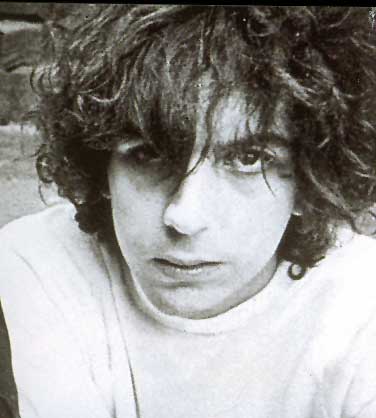
"...TO SEE FARTHER INSIDE OF ME"
During an appearance on Dick Clark's American Bandstand, where the Pink Floyd were supposed to mime to their "See Emily Play" single, they found that Syd wasn't into moving his lips that day. Then came The Pat Boone Show, wherein the antiseptic Fifties idol's vain attempts to coax a word out of Barrett were rewarded with the disconcertingly blank stare that Waters would characterize (in his famous ode to Syd) as "a look in your eyes, like black holes in the sky." At this point Andrew King cancelled all remaining dates and sent the boys home.
Barrett did come up with a follow-up to "Emily": "Apples and Oranges," an oblique paean to "shopping at shops" ("their most psychedelic single yet,'' said NME) that was never issued in the U.S. and flopped dismally in the U.K. "Couldn't care less," said Syd, who had wanted the single to be his new song "JugBand Blues" the number that Jenner would call "the ultimate self-diagnosis on a state of schizophrenia," citing lines like "I'm most obliged to you for making it clear that I'm not here, and I'm wondering who could be writing this song. This would prove the only one of three new Barrett compositions to be included for the second Pink Floyd LP; the other two were called "Scream Thy Last Scream" and "Vegetable Man”, which to this day have remained unreleased in commercial form. A pity, because they are both characterful and kaleidoscopic original songs!
On the original lineup's last British tour (supporting Jimi Hendrix), Syd was prone to let his arm dangle limply from his trademark mirrored Telecaster, or play a single chord throughout the set. One such night, frantically arranging his "obligatory Hendrix perm" just before the Floyd were due onstage, Barrett is said to have crushed the contents of a jar of Mandrax tablets and poured the crumbs onto his head along with a tube's worth of Brylcream. Under the heat of the spotlights, the dribbling mess gradually transformed Barrett's face into a melting horror mask.

"SO I WENT AHEAD AROUND MY WORLD..."
Sometimes he refused to leave the tour bus altogether, allowing Dave O'List from the bottom-billed Nice to deputize for him. That they actually could more or less "manage without Syd" proved a revelation to the rest of the group. And so began the slow exit of Syd from the band. One which I feel was augmented by Syd himself, disgusted with those around him stunting his “out there” creative and artistic capabilities.
In Rolling Stone a decade later, Gilmour remembered Barrett as "the brightest, wittiest, and most popular guy I knew. Whether acid or success acted as the catalyst, I couldn't tell, but gradually he was just not in the same world as you and I. You would ask him questions and get an answer to something else entirely."
Barrett then announced that he was bringing in a pair of his court jesters, a banjo player and a saxophonist to turn the Floyd into a six-piece. But Waters, Wright, and Mason had other ideas. In March 1968, Melody Maker reported that "a new singer and guitarist has joined the Pink Floyd, increasing their lineup to five. He is twenty-one-year-old David Gilmour, a childhood friend of the Floyd's Syd Barrett and Roger Waters." According to Jenner, Gilmour (who had been working as a male model) was a fine technician who lacked a distinctive style of his own, but could do "very effective takeoffs" of guitarists like Jimi Hendrix. So the band said, “Play like Syd Barrett!”

SYD FADES INTO THE DISTANCE OF THE FLOYDIAN LANDSCAPE
"So we were teaching Dave the numbers," Mason told Zigzag, "but Syd came in with some new material. The song went `Have You Got It Yet?' and he kept changing it so no one could learn it." "It was a real act of mad genius," added Waters. "I didn't suss it out at all. I stood there for an hour while he was singing… trying to explain that he was changing it all the time so I couldn't follow it. He'd sing 'Have you got it yet?' and I'd sing `No, no!'
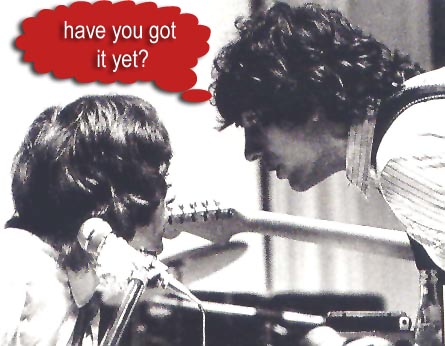
"I thought the only way that we could carry on together was for him to be still a member of the group, still earn his fair share of the money, but not to come to gigs at all, be a sort of Brian Wilson figure if you like, write songs and come to recording sessions".
But Jenner and King, who felt that Barrett was the Floyd, took exception to the proposed downgrading of his status in the group. The upshot was that Syd was eased out of the Floyd, and the Floyd was eased out of the Blackhill partnership after its co-managers decided to place their bets on Barrett's proposed solo career.
Barrett's departure in March 1968 did not prevent him from turning up at Floyd gigs, standing in front of the stage and levelling his catatonic stare at his hapless replacement. Even so, Gilmour would go to heroic lengths to facilitate Barrett's re-emergence on a pair of solo LP’s. It must be said that this was done not out of guilt for replacing Syd in the band, but Gilmour genuinely recognising the latent talent still engrained in Syd’s often fragile mind. He was one of the few that could still communicate with Barrett on “his” level. Gilmour’s compassion can be heard during conversation in the out-takes of recently re-mastered CD’s.
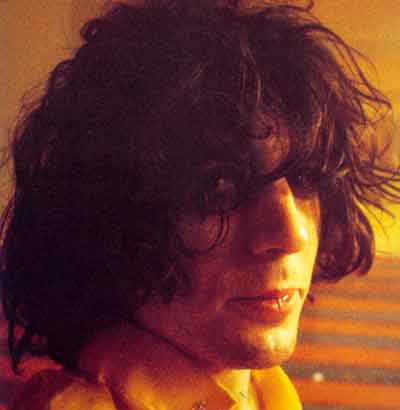
"HIDE YOUR WINGS IN A GHOST TOWER..."
In January 1970, Syd’s first solo album was released. The first half of the album (6 songs) was actually produced by Malcolm Jones, head of EMI's new "progressive" label, Harvest (to which the Floyd themselves had been rerouted). When Jones gave up in despair and impatience, Gilmour and Waters volunteered to replace him, bringing along the Soft Machine and Willie Wilson (from Quiver) for instrumental support. The album was Syd in honest, raw and truly surreal mode. A very Syd album! Every song had a distinct melody of it’s own, melodies which still seemed to flow very easily out of Syd’s truly unique psyche. Clearly a James Joyce fan, Syd penned some beautiful new music which gave the poem timeless affirmation. Occasionally, the phantasmagoria gave way to lucid commentary on the artist's own confused mental state: "Inside me I feel so alone and unreal…Please lift a hand, I’m only a person…and…I tattooed my brain all the way."
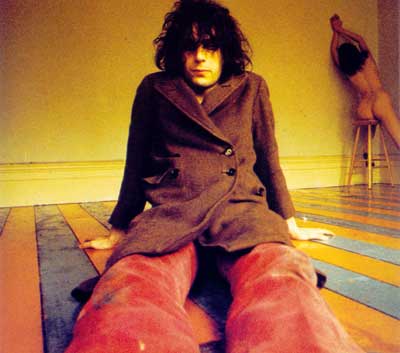
"WATCHING THE FIRE DANCE ON THE FLOOR..."
Syd was living at Wetherby Mansions in Earls Court London at the time, and contributed to the Album’s dynamic sleeve, by painting the floorboards of his roomy flat with opposing Orange and Turquoise coloured paint. A unique album which almost certainly can be enjoyed even more by listening to it late at night.
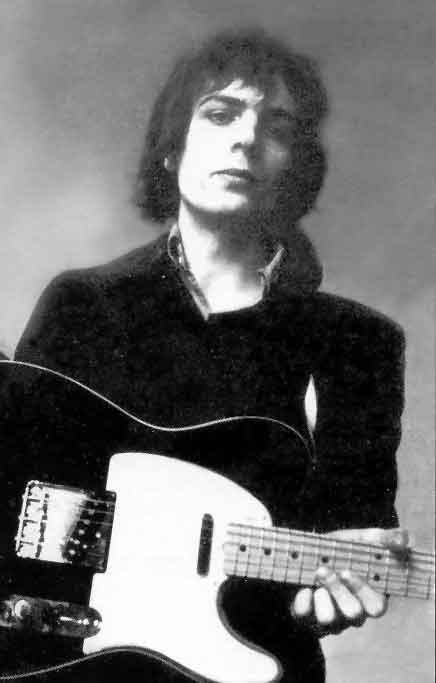
SYD WITH HIS EVER FAITHFUL FENDER TELECASTER
In November 1970, after a brief spell, the second LP, Barrett, would be co-produced by Gilmour and Wright, this time without Water’s involvement. Barrett's new solo work was similar in structure and content to his last, only the production feels a little more polished and refined. Accompanied by Richard Wright (on Piano, Organ and Harmonium), Jerry Shirley (on Drums) and Gilmour (now on Bass guitar), the fresh album Barrett said, “The important thing is that it is better than the last”. Barrett performed some of the material on "progressive" radio programs and at a London music festival, after which he moved back to his mother's house in Cambridge. The album was another example of how easy an amazing tune and original lyrics could be created in such short spaces of time. The sleeve again had a contribution from Syd’s artistic abilities, some drawings he had done of some bees and beetles. The songs were superb and the album had a timeless, classically English eccentric charm all of it’s own. Gilmour commented recently that Syd’s one take at recording a backwards played guitar on the track Dominoes, would be impossible for the rest of us, and therefore could only be described as the work of a true genius. Richard and David’s playing is rich and fluent, giving this album more of a band feel. We are so lucky that Syd’s friends and ex-colleagues were able to get him into the studio and get these songs down on tape before they were lost in the blackness of time.
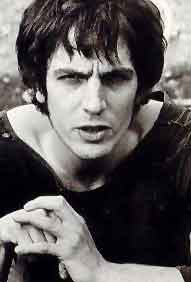
"THE MILDER I GAZE..."
Syd subsequently announced he was planning a third album to consist of "twelve jolly good singles", but sadly none ever materialized. Though his solo LP’s would go unreleased in the U.S. until 1974, a Rolling Stone writer who tracked Barrett down in Cambridge reported that he looked "hollow-cheeked and pale, his eyes reflecting a permanent state of shock. He has a ghostly beauty which one normally associates with poets of old." Like his own songs, Syd seemed alternately lucid and elliptical. He said he felt "full of dust and guitars" and, at twenty-five, afraid of getting old. "I think young people should have fun, but I never have any." Nonetheless, he insisted he was "totally together," adding: "I'm not anything that you think I am anyway."
In early 1972, with a makeshift band called Stars, consisting of bassist Jack Monck and ex-Tomorrow, Pretty Things, and Pink Fairies drummer John Charles "Twink" Alder. Syd looked set to return to the music world once again. They rehearsed in the basement of the Barrett home, learning classic numbers such as Dark Globe and Octopus. First up they played two free gigs at at the Dandelion Café and an open air affair in Cambridge’s Market Square.

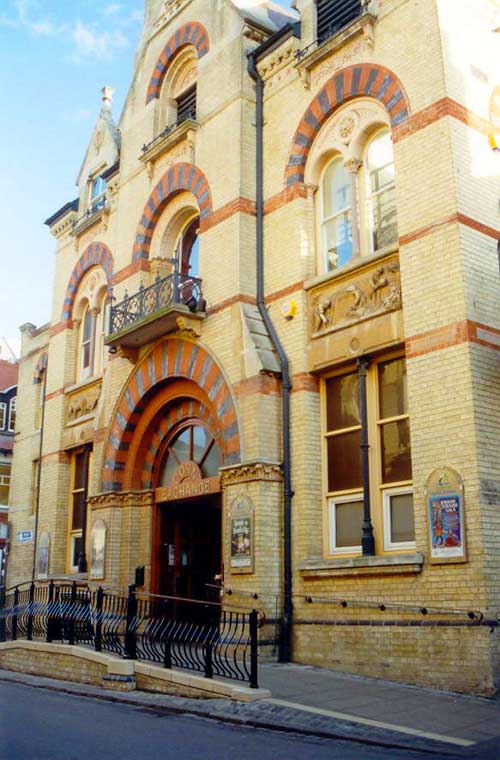
A VERY RARE SHOT OF SYD HOLDING HIS GUITAR AND PLAYING IN CAMBRIDGE'S MARKET SQUARE. NOT FAR AWAY WAS THE NEXT GIG AT THE CORN EXCHANGE
Twink then arranged for Barrett’s new trio to appear at the Cambridge Corn Exchange. This poorly promoted gig, although brilliant and in classic Syd style was not received well and when Syd saw the review the following week he stormed around to Twink’s home to tell him it was all over! This was clearly a defining moment in Syd’s life, to make the decision to cut off his talents from the music world.
In retirement, the Piper's ever-growing legend was fanned by one of the most zealous cults ever known to rock & roll. The appearance in 1972 of a Barrett fanzine called Terrapin (after a song from Madcap) triggered an overwhelming response from Syd fans in some fifteen countries, including Brazil, Israel, and the U.S.S.R. Despite its increasing reliance on fan poetry and artwork and Syd Barrett crossword puzzles, Terrapin eventually ran out of old clippings and lyrics to reprint. As editor John Steele was forced to note in one of his last (and slimmest) issues, "the Society cannot keep on functioning if there is nothing new to report, and people tire of old records, no matter how amazing they may be." Yet there would be little further news about Syd Barrett, other than the occasional tragicomic anecdote, such as the one about his visit to a King's Road boutique, where he selected three different sizes of the same pair of trousers, claiming they all fit him perfectly.
As Syd has settled into a more relaxed and stable mental state in his late fifties, his cult-status has flourished with more young fans getting into his unique music more than ever. Especially the more creative, Art student and University brigade.
To some extent, Barrett's latter-day cult resembles that of the late Jim Morrison, but Syd is still very much alive! This cult status vicariously feeding upon the bizarre escapades of a brilliant and charismatic counter-cultural icon who evidently let himself be ruled (and eventually destroyed) by the weirder implications of his own art and public image. Barrett's story, in any case, certainly provides a cautionary tale of the toll that the glamorous Rock Business exacts from its most sensitive and creative innovators. Indeed, these two interrelated themes the exploitative tendencies of the music industry, and the artist's descent into mental unstability would permeate Pink Floyd's subsequent work (and occasionally prod them into forgoing their robotistic aloofness for the very human emotions of, respectively, anger and compassion). By the same token, Syd Barrett's ongoing mystique and importance derived in part from his unwitting influence on the albums that, after his departure, would establish his former group as one of the world's leading rock bands. It couldn't have happened without him!
Jenner, along with most people familiar with the Floyd, not only couldn't imagine the band amounting to much without it’s singer/songwriter/guitarist, but also supposed that the general public would share these sentiments and refuse to take the new line-up seriously. They were wrong on both counts.
Tired of crazed and excited fans calling on his doorstep in Cambridge, Syd eventually moved back to London in 1974, to be sustained by growing royalties from the Floyd's classic first album. Syd moved into Chelsea Cloisters in South Kensington, living in room 902 way up high on the ninth floor, offering him welcome and peaceful seclusion. It was also thought, that the elusive third album, may have been invented. Sadly it was not. He was coaxed back into the studios of Abbey Road for four days, and recordings were made, but Syd simply didn’t seem interested, and nothing ever became of those sessions. He would never record at Abbey Road again, but he would return there in 1975, maybe out of psychic “knowing” that the band he had created were now writing an entire album “about” him. He had reportedly strapped on a guitar to ask when it was his turn? Syd’s sister Rosemary claims it was a practical joke, on Syd’s behalf, which simply backfired. It wouldn’t have been right for Barrett to strum along to a tune written “for” him. Called Wish You Were Here, the lyrics and music deeply re-affirmed what a truly gifted, sadly missed and loved character he was.
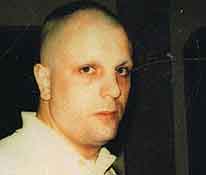
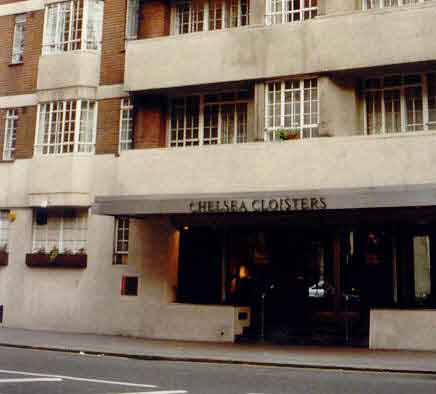
Syd dropped in at Abbey Road in 1975, whilst living here at Chelsea Cloisters in London
Barrett continued to do little, except watch Television, and he returned to Cambridge to live with his mother in 1981.
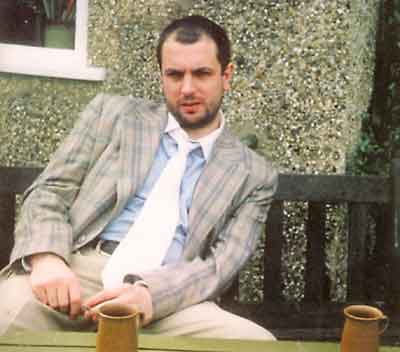
"LAZING HERE ON A PAINTING DREAM..."
He did return to Chelsea Cloisters in 1982 for a few brief weeks, perhaps to try again at getting creative and work in solitude, but he decided he was tired of London and walked back to Cambridge (some 50 miles) where he would remain retired and reclusive.

"SEEMS TO BE ALL AND IT'S ROSY, IT'S A BEAUTIFUL DAY..."
In 1988, a full 18 years after Roger Keith (Syd) Barrett’s last studio album was released, EMI decided to release Opel. Primarily encouraged by rabid enthusiasts who had long desired the official release of remaining songs above the substandard quality of bootlegs. The songs consisted of alternate versions and left over material from Syd’s two solo albums. Almost all of Opel is Syd on acoustic guitar, but it has inherited some quite superb pieces. Most the equal of what went before. Further proof of Barrett’s gift for a beguiling, fragile but richly flavoured psychedelic music, carried by lyrics which were best described as whimsical wordplays and visions. The title track, again shows Barrett analysing his state of play by ending with him singing…I’m living…I’m trying…I’m giving…to find you. Opel is not the kind of album to lay the legend to rest, instead encourages a further lamenting for this romantic and talented figure. Opel sparkles in many many spots with his individual tuneful visions. Shine on indeed!
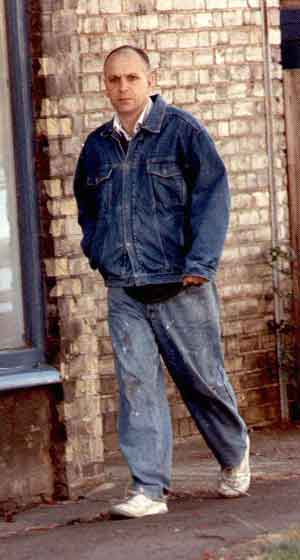
"And I wondered for those I love still..."
Sadly in 1991, Syd would lose his other parent. Upon the death of his Mother Winifred, he destroyed all his old diaries and art books, plus chopped down the front garden’s fence and tree. Possibly in a mental state of renewal, and a feeling of grief that now both of his caring and doting parents would no longer be around to see any new strokes of genius, he entered a new phase of solitude.
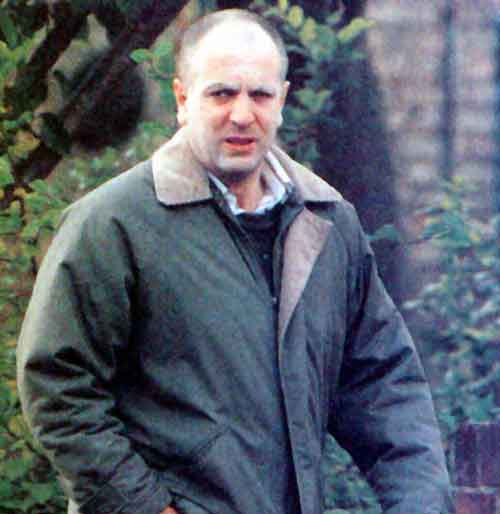
"In the sad town, cold iron hands..."
In 1992 Atlantic Records offered him 75,000 British Pounds to record anything he wanted, in his home if necessary. Although his family considered the offer, Barrett simply declined. That same year a smartly designed Box Set was released, including many high quality Studio Out-takes, with quite a few sounding distinctly different, with Syd truly shining in a new light. It was certainly welcomed by the fans, who before it’s release had only heard dodgy bootlegs.

Syd in 2001
2001 saw the release of a new “Best Of” release for Syd Barrett called Wouldn’t You Miss Me? It offered a new song, which had been dug up by Gilmour, after three decades from it’s creation! The track called Bob Dylan Blues, was originally recorded on February 27 1970, for a demo session. It was a very fresh dynamic sounding Barrett tune, again welcomed by overly keen fans, who were still anxiously waiting for an official studio release of Vegetable Man and Scream Thy Last Scream.
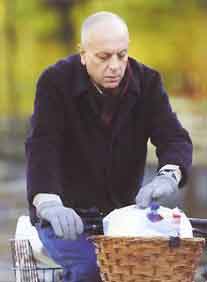
Syd riding his bike back home from the shops (2002)
At the turn of this new century, with many disasters and tragedies rocking the world, Syd was probably in a better mental state than ever, living his life just like most normal people. Caring for his health and his home, doing the odd painting perhaps, garden maintenance or just relaxing, watching Television. If he has picked up a guitar, it has been in the privacy of his own home, but like most of us, motivation is a difficult thing, so it is easier to not to play than to go ahead and invent. We can only hope and pray, that he is now at peace inside that truly exceptional soul of his.
Syd passed away peacefully at home in Cambridge on July 7th 2006, aged 60
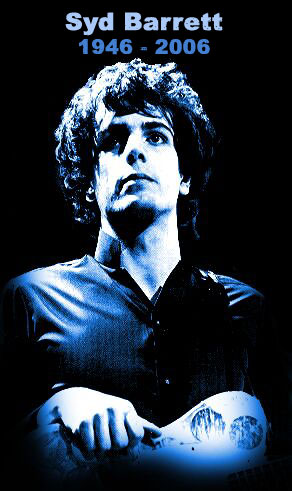
SHINE ON you Astral Piper...
